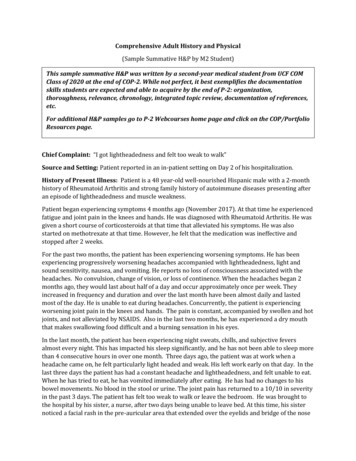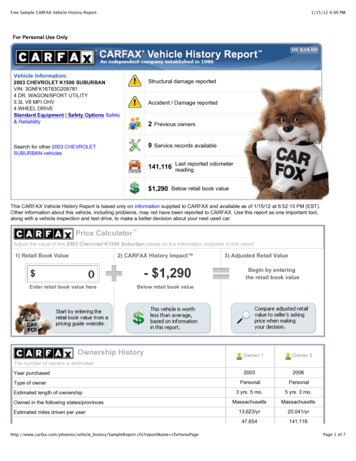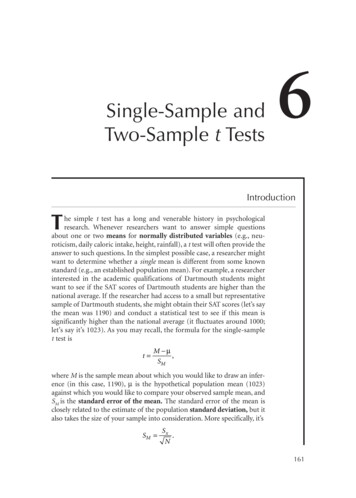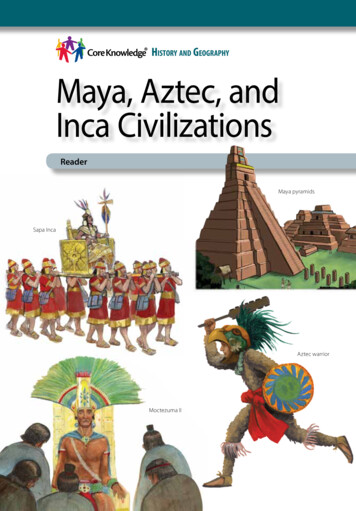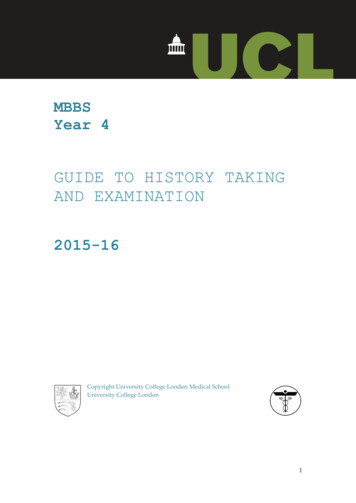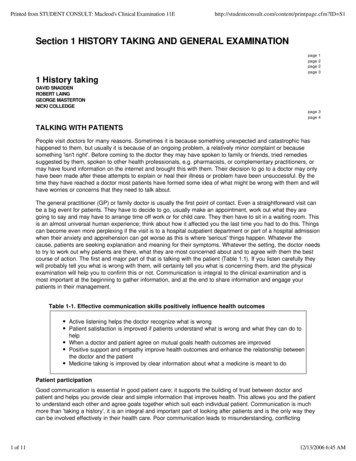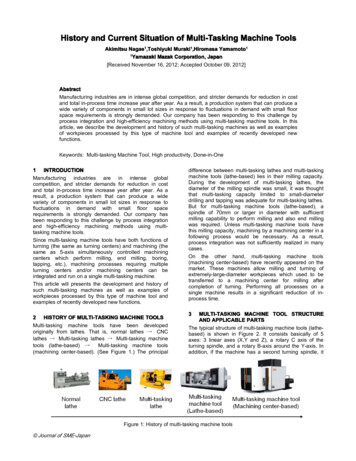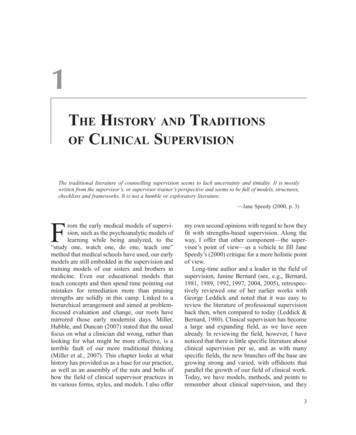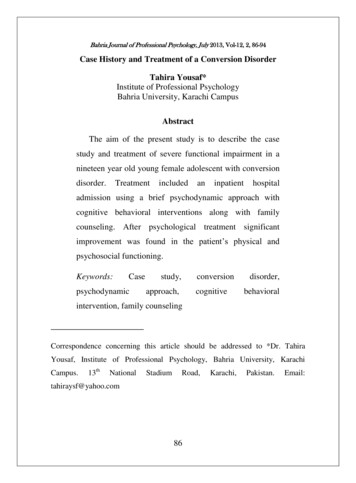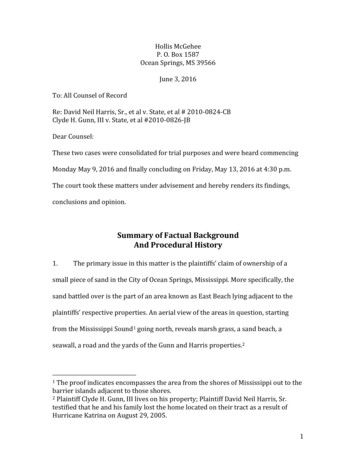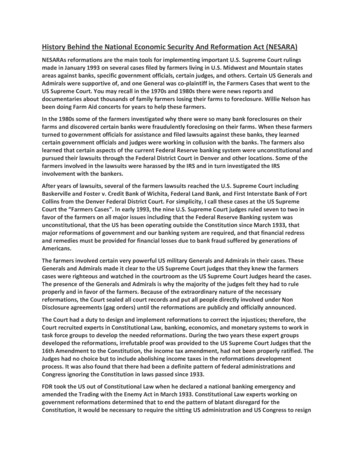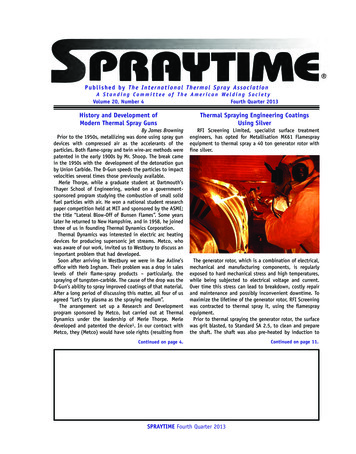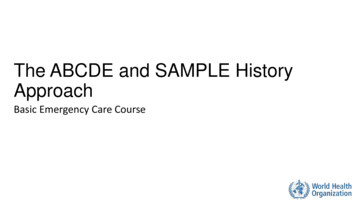
Transcription
The ABCDE and SAMPLE HistoryApproachBasic Emergency Care Course
Objectives List the hazards that must be considered when approaching an ill or injured person List the elements to approaching an ill or injured person safely List the components of the systematic ABCDE approach to emergency patients Assess an airway Explain when to use airway devices Explain when advanced airway management is needed Assess breathing Explain when to assist breathing Assess fluid status (circulation) Provide appropriate fluid resuscitation Describe the critical ABCDE actions List the elements of a SAMPLE history Perform a relevant SAMPLE history.
Essential skills Assessing ABCDE Cervical spine immobilization Full spine immobilization Head-tilt and chin-life/jaw thrust Airway suctioning Management of choking Recovery position Nasopharyngeal (NPA) and oropharyngealairway (OPA) placement Bag-valve-mask ventilation Skin pinch test AVPU (alert, voice, pain, unresponsive)assessment Glucose administration Needle-decompression for tensionpneumothorax Three-sided dressing for chest wound Intravenous (IV) line placement IV fluid resuscitation Direct pressure/ deep wound packing forhaemorrhage control Tourniquet for haemorrhage control Pelvic binding Wound management Fracture immobilization Snake bite management
Why the ABCDE approach? Approach every patient in a systematic wayRecognize life-threatening conditions earlyDO most critical interventions first - fix problems before moving onThe ABCDE approach is very quick in a stable patientGoals: Identify life-threatening conditions rapidly Ensure the airway stays open Ensure breathing and circulation are adequate to deliver oxygen tothe body
What is a SAMPLE history? Categories of questions to obtain a patient’s history Signs and Symptoms Allergies Medications Past medical history Last oral intake Events Immediately follows the ABCDE approach Allows providers to easily communicateGoal: Rapidly gather history critical to the management of the acutely ill patient
ABCDE: Initial Approach The most important step is to stay safe! Scene safety FireMotor vehicle crashBuilding collapseChemical spillViolenceInfections disease Personal Protective equipment GlovesGownMaskGogglesHand washingPersonal protective equipment
Safety considerations Scene safety Scene hazardsViolenceInfectious disease risk Use personal protective equipment Consider appropriate PPE for situationGloves, eye protection, gown and mask Cleaning and decontamination Use PPE and wash your hands before and after every patient contact (or alcohol gel cleanser)Clean/disinfect surfacesRefer to local decontamination protocols for chemical exposures Ask for help early Multiple patientsMake arrangements if transfer is neededKnow who to call for infectious outbreaks or hazardous exposures
Workbook Question 1:SafetyA person walks into your health post vomiting, bleeding from themouth and complaining of abdominal painDescribe what is needed to safely approach this patient:
ABCDE Approach: Elements Airway with cervical spine immobilization: Check for obstruction If trauma-immobilize cervical spine Breathing plus oxygen if needed: Ensure adequate movement of air into the lungs Circulation with bleeding control and IV fluids Determine if there is adequate perfusion Check for life-threatening bleeding
ABCDE Approach: Elements Disability: AVPU/GCS, pupils and glucose Assess and protect brain and spinal functions Exposure and keep warm Identify all injuries and environmental threats Avoid hypothermiaThis stepwise approach is designed to ensure that life-threatening conditions areidentified and treated early, in order of priority.A problem discovered (A-B-C-D-E) must be addressed immediatelybefore moving on to the next step.
REMEMBER Always check for signs of trauma in each ofthe ABCDE sections, and reference the traumamodule as needed.
Airway Assessment
Airway Management If the patient is unconscious and not breathing normally: If no concern for trauma: open airway using HEADTILT/CHIN-LIFT manoeuvre If trauma suspected: maintain c-spine immobilization anduse JAW-THRUST manoeuvre Consider placing an AIRWAY DEVICE to keep the airway open Oropharyngeal airway Nasopharyngeal airwayAdult jaw thrust
Airway Management: Choking If foreign body is suspected: Visible foreign body: carefully REMOVE IT If the patient is able to cough or make noise, keep the patient calm ENCOURAGE to cough If the patient is choking (unable to cough/make sounds) use age-appropriate CHESTTHRUSTS/ABDOMINAL THRUSTS/ BACK BLOWS If the patient becomes unconscious while choking: follow CPR PROTOCOLSChest thrust in infantBack blows in infantChest thrust in adultAbdominal thrust in late pregnancy
Airway Management: If secretions are present: SUCTION airway or wipe clean Consider RECOVERY POSITION if the rest of the ABCDE is normal and no trauma If the patient has swelling, hives, or stridor, consider a severe allergicreaction (anaphylaxis) Give intramuscular ADRENALINE Allow patient to stay in position of comfort Prepare for HANDOVER/TRANSFER to a center capable of advanced airwaymanagement
AirwayQUESTIONS?
Breathing: Assessment Look, listen and feel to see if the patient is breathing Assess if the breathing is very fast, very slow or very shallow Look for increased work of breathing Accessory muscle workChest indrawingNasal flaringAbnormal chest wall movement Listen for abnormal breath sounds REMEMBER with severe wheezes there may be no audible breathsounds because of severe airway narrowing
Breathing: Assessment Listen to see if breath sounds are equal Check for the absence of breath sounds on one side If dull sound with percussion to the same side THINK large pleural effusion or haemothroax If also hypotension, distended neck veins or tracheal shift THINK tension pneumothorax Check oxygen saturation
Breathing: Management If unconscious with abnormal breathing, perform BAG-VALVE-MASK-VENTILATION with OXYGEN andfollow CPR PROTOCOLS If not breathing adequately (too slow or too shallow) begin BAG-VALVE-MASK-VENTILATION with OXYGEN If oxygen is not immediately available, do not delay ventilation Plan for immediate TRANSFER for airway management If breathing fast or hypoxia, give OXYGEN If wheezing, give SALBUTAMOL If concern for anaphylaxis, give intramuscular ADRENALINE If concern for tension pneumothorax, perform NEEDLE DECOMPRESSION, give OXYGEN, give IV FLUIDS Plan for immediate transfer for chest tube If concern for pleural effusion, haemothorax, give OXYGEN Plan for immediate transfer for chest tube If cause unknown, consider trauma
BreathingQUESTIONS?
Circulation: Assessment Look, listen and feel for signs of poor perfusion Cool, moist extremities Delayed capillary refill Diaphoresis Low blood pressure Tachypnoea Tachycardia Absent pulses
Circulation: Assessment Look for internal and external signs of bleeding Chest Abdomen From stomach or intestines Pelvic fracture Femur Fracture From wounds Check for pericardial tamponade Hypotension Distended neck veins Muffled heart sounds Check blood pressure
Circulation: Management For cardiopulmonary arrest follow relevant CPR PROTOCOLS If poor perfusion: GIVE IV FLUIDS If external bleeding: APPLY DIRECT PRESSURE If internal bleeding or pericardial tamponade, REFER to centre withsurgical capabilities If unknown cause, remember trauma Apply BINDER for pelvic fracture or SPLINT for femur fracture withcompromised blood flow
CirculationQUESTIONS?
Disability: Assessment Assess level of consciousness AVPU or GCS in trauma Check for low blood glucose (hypoglycaemia) Check pupils (size, reactivity to light and if equal) Check movement and sensation in all four limbs Look for abnormal repetitive movements or shaking Seizures/convulsions
Disability: Management If altered mental status, no trauma, ABCDEs otherwise normal place in RECOVERY POSITION If altered mental status, low glucose ( 3.5mmol/L) or if unable to checkglucose Give GLUCOSE If actively seizing Give BENZODIAZEPINE If pregnant and seizing Give MAGNESIUM SULPHATE
Disability: Management If small pupils and slow breathing, consider opioid overdose Give NALOXONE If unequal pupils, consider increased pressure in the brain RAISE HEAD OF BED 30 DEGREES if no concern for spinal injury Plan for early TRANSFER/REFERRAL If unknown cause of altered mental status, consider trauma IMMOBILIZE the cervical spine
DisabilityQUESTIONS?
Exposure: Assessment Examine the entire body for hidden injuries, rashes, bites orother lesions Rashes, such as hives, can indicate an allergic reaction Other rashes can indicate infection
Exposure: Management If snake bite is suspected IMMOBILIZE the extremity Take a picture of the snake (if possible) to send to referral hospital General exposure considerations REMOVE constricting clothing and jewelry COVER the patient to prevent hypothermia Acutely ill patients may be unable to regulate body temperature PREVENT hypothermia Remove wet clothing and dry patient thoroughly Respect the patient’s modesty If cause unknown, remember trauma LOG ROLL for suspected spinal cord injury
ExposureQUESTIONS?
In-Depth, Acute, Life-ThreateningConditions Obstruction:foreign body Obstruction:burns Obstruction:anaphylaxis Obstruction:trauma Tensionpneumothorax Opiate overdose Asthma/COPD Large pleuraleffusion/haemothorax PulselessnessShockSevere bleedingPericardialTamponade Hypoglycaemia Increasedpressure on thebrain Seizures/convulsions Snake bite
Airway Obstruction: Foreign BodySigns and Symptoms Visible secretions, vomit or foreign bodyAbnormal sounds from airway Stridor, snoring, gurglingMental status changes - airwayobstruction from tonguePoor chest riseManagement REMOVE or SUCTION visible foreign body/fluid ifpossible Do not push further into airway If completely obstructed Use age-appropriate CHESTTHRUSTS/ABDOMINAL THRUSTS/ BACK BLOWS For obstruction due to tongue Open the airway using HEAD-TILT and CHIN LIFTor JAW THRUST (trauma) Place OPA or NPA as needed Plan for HANDOVER/TRANSFER
Airway Obstruction: Burns Signs and SymptomsBurns to head and neckBurned nasal hairs/sootAbnormal sounds from airway Stridor, snoring, gurglingPoor chest rise ManagementGive OXYGEN to all patients with burninjuriesOpen the airway using HEAD-TILT andCHIN LIFT or JAW THRUST (trauma)Place OPA or NPA as neededMaintain c-spine IMMOBILIZATION ifthere is traumaPlan for HANDOVER/TRANSFER Rapid airway swellingBurns can cause airway swelling due to inhalation injuries!
Airway Obstruction: Severe AllergicReactionSigns and Symptoms Mouth, lip and tongue swellingDifficulty breathing Stridor and/or wheezingRash or hivesTachycardia and hypotensionAbnormal sounds from airway Stridor, snoring, gurglingPoor chest riseManagement MONITOR for airway obstruction Give ADRENALINE for airway obstruction,severe wheezing or shock Can wear off in minutes, need additionaldoses Start IV/ give IV FLUIDS REPOSITION AIRWAY as needed Sit patient upright (no trauma) Give OXYGEN If severe or not improving, plan forHANDOVER/TRANSFER
Airway Obstruction: TraumaSigns and Symptoms Neck haematomaAbnormal sounds from airway Stridor, snoring, gurglingChange in voicePoor chest riseManagement SUCTION to remove any blood Open airway using JAW THRUST Place an OPA as needed Do not use NPA with facial trauma Maintain SPINE IMMOBILIZATION Plan for HANDOVER/TRANSFERIn head/neck injuries obstruction can be from blood or due to the trauma itselfPenetrating wounds to neck cause obstruction from expanding hematoma
For any abnormal airway sounds,REASSESS the airway frequently aspartial obstruction might worsen tocompletely block the airway
Breathing Conditions: TensionPneumothoraxSigns and Symptoms ManagementHypotension with difficulty breathing Perform NEEDLE DECOMPRESSION, giveand any of the following:OXYGEN and IV FLUIDS Distended neck veins Plan for HANDOVER/TRANSFER Absent breath sounds on affected Patient needs chest tubeside Hyperresonance with percussion onaffected side May have tracheal shift away fromaffected sideAny pneumothorax can become a tension pneumothorax
Breathing Conditions: Suspected OpiateOverdoseSigns and Symptoms Slow respiratory rate (bradypnea)HypoxiaVery small pupilsManagement Give NALOXONE to reverse opiatemedications MONITOR closely Naloxone may wear off before opiate Give OXYGENOpioid medications (such as morphine, pethidine and heroin) can decrease the body’sdrive to breathe
Breathing Conditions: Asthma/COPDSigns and Symptoms WheezingCoughAccessory muscle useMay have history of asthma/COPD,allergies or smokingManagement Give SALBUTAMOL as soon as possible Give OXYGEN if indicatedAsthma and COPD are conditions causing spasm in the lower airway
Breathing Conditions: Large PleuralEffusion/ HaemothoraxSigns and Symptoms ManagementDifficulty in breathing Give OXYGENDecreased breath sounds on affected Plan for HANDOVER/TRANSFERside Patient may need chest tubeDull sounds with percussion on affectedsideWith large amount of fluid could havetracheal shiftPleural effusion occurs when fluid builds up in the space between the lung and thechest wall or diaphragm limiting the expansion of the lungs
Circulation Conditions:PulselessnessSigns and Symptoms No pulseUnconsciousNot breathingManagement Follow relevant CPR PROTOCOLS
Circulation Conditions: ShockSigns and Symptoms Rapid heart rate (tachycardia)Rapid breathing (tachypnoea)Pale and cool skinCapillary refill 3 secondsSweating (diaphoresis)May have: Dizziness Confusion Altered mental status HypotensionManagement LAY FLAT if
Objectives List the hazards that must be considered when approaching an ill or injured person List the elements to approaching an ill or injured person safely
